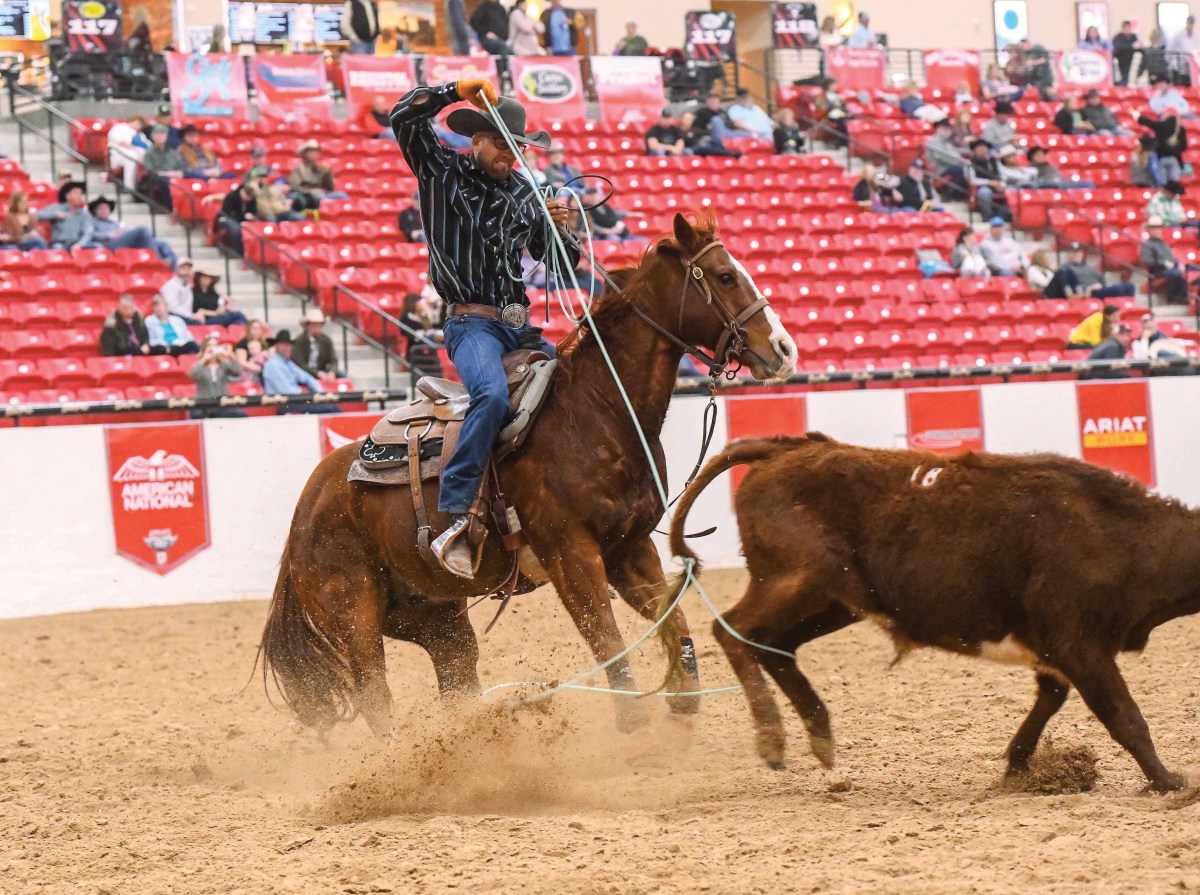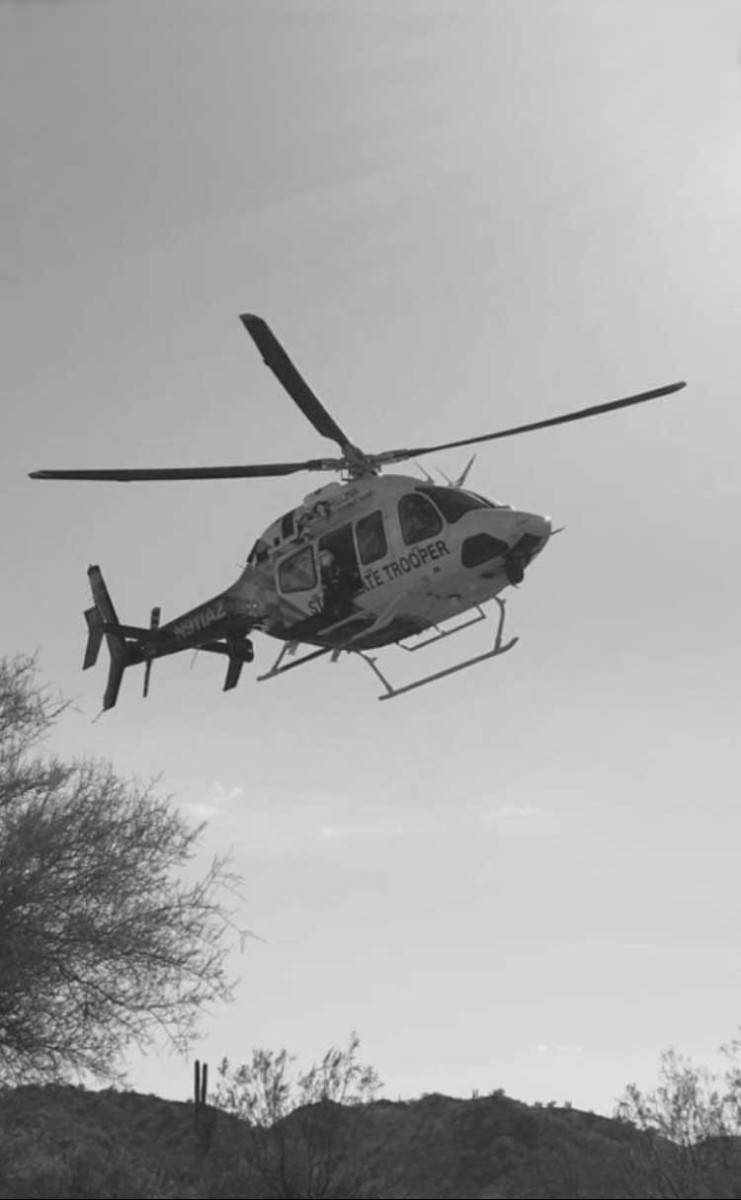Growing up on a central Arizona ranch, Lowell Neshem, 40, who took home $76,500 after heeling for a third-place check in the 2018 #11 Boehringer-Ingelheim WSTR Finale, would mount up and help his cowboy dad with occasional burro roundups.
“When I was a kid,” Neshem, who had an early knack for mechanics, explained, “there was a guy who was contracted with the BLM, and he would gather the wild burros on our ranch with the helicopter. I was on a horse and he would push the burros to us. We’d try to trap them in a fence trap, but a lot of them, we would just rope. And I remember being really intrigued with the helicopter, like, that it could even fly. I was asking the pilot all about it when I was like 14.”

The flying idea didn’t take hold immediately. Neshem finished school and, deciding he wanted to see some of the world, joined the Navy in 1999. He became a Seabee—a member of the Construction Battalion—so that when the events of 9/11 took place in the middle of his enlistment, he deployed to Bahrain to prepare for war.
“I went to Bahrain right after Sept. 11, and we were staged there to potentially deploy into Afghanistan, but I just sat there for six months. When I came back to the U.S., I was supposed to get out in January and my battalion was deploying in December to Iraq. I didn’t think they were going to let me out, but they did.”
That childhood glimmer of flying began to sprout in Neshem’s mind, which first manifested in the form of planes, until Neshem realized helicopters—like the ones that were used to assist with the burro roundups—might provide more diverse job opportunities. He shod horses for the next year to save money for helicopter flight school.
“I had a ’96 Dodge pickup, and I loaded up everything I owned, and I had a briefcase full of cash from shoeing horses and showed up in Idaho and started flying. And I was really nervous. My parents don’t have money, so it was kind of a big gamble for me. If it didn’t work, I was going to be in a bind. I was 24, and I had a lot of anxiety starting flight school.”
With so much on the line, Neshem immersed himself in self-taught ground school (all the lessons that need to be learned that don’t involve actual flight) and got in the air as often as possible.
“I lived, ate and slept flying helicopters,” he said. “I was trying to get through flight school spending the least amount of money that I could, and I got my commercial license in just over six months.”
Neshem’s single-minded devotion to his pursuit paid off. He was employed as a flight instructor when he was hired by a tour operator in Alaska, where Neshem flew tourists over the glaciers for the summer of 2005. During that time, he also managed to expertly handle an engine failure with five vacationers aboard.
“It’s really rare. I don’t really know anyone else that’s had an actual engine failure. We were just taking off out of the airport, which is kind of the worst place for it to happen because you’re climbing and you’re using a lot of power and you don’t have a lot of air speed or altitude to work with. Fortunately, I had been teaching the auto rotations all the way up until I went to Alaska because I was a flight school instructor. So, at that time, I was more proficient than I am now because, at that time, I was teaching it every day.

Courtesy of Lowell Neshem
“We were like 250 feet up. We came down pretty hard and banged up the helicopter pretty good. Smashed the skids. The helicopter caught on fire. It was crazy. It was July 25, 2005. I still remember it like it was yesterday. Fortunately, we were all fine and no one got hurt.”
The rare and successful event helped Neshem secure a job following the summer tour season as a pilot for a hospital in San Angelo, Texas—a true coup for a young pilot who had only even enrolled in flight school a year-and-a-half earlier. In 2007, he returned to Alaska for its superior flying opportunities, followed by a return to the Texas hospital, and then a position opened for the hospital in Cottonwood, Arizona, giving Neshem a chance to return to his home state and to be close to his parents nearly 10 years after he’d left to join the Navy.
“That’s when I started riding again,” said Neshem, who, in high school, had ridden broncs for the high school rodeo team. “I got a horse again and started roping a little bit. I was a 4 and probably should have been a 3. I hadn’t roped and never was good at it, so I got a Hot Heels and started roping it.”
The nature of his work and its multiple-days-on, multiple-days-off schedule allowed Neshem to have real time for personal interests like roping, working on diesel trucks, and helping his parents out on the ranch, now just 40 miles west of where he was living in Prescott Valley. Plus, the 2008 recession meant the search for more job opportunities took a real downturn, and Neshem found himself in a good place to sit tight, even if the flying proved to be rather uninspiring for his tastes.
Finally, in 2013, a position opened up at the Arizona Department of Public Safety, for a search-and-rescue pilot. It was the opportunity Neshem had been waiting for—challenging flying, a good schedule, exciting missions close to home, which now included a wife and a young son—but, uncharacteristically, he nearly walked away from it almost immediately after being hired on.
“I got hired and then they make you go through the Police Academy,” Neshem explained. “I had to go down to the Arizona Law Enforcement Academy in Phoenix for 21 weeks of boot camp. I hated it. I absolutely hated it. I never wanted to be a cop. I didn’t have any interest in it, and I was 34 years old. The first time I went through boot camp, I was 19 years old, and it was no problem. Now, I was 34 and I was polishing boots, and they keep you up all night and, about two weeks in, it was a real mental struggle. I was ready to leave and just go back to flying helicopters and say, ‘forget this.’
“They kind of sensed that. All of your instructors are all cops, so they knew I wasn’t into the cop thing, They’d call me out on that and I was like, ‘I’m here to fly the helicopter. I don’t really care about this stuff.’ So that was one of the more challenging mental things I’ve done, getting through the law enforcement academy.”
The other really challenging thing Neshem has engaged in is team roping.
“I started working on team roping in 2009 or ’10, and I didn’t win anything until 2015. Roping can be one of the most frustrating things out there. I guess I’m stubborn. I got to the point in late 2014, early 2015, where I said, ‘I’m going to spend another year and I’m going to put everything I’ve got into working at heeling, and if I don’t get better, I’m going to quit. I’m going to move on.”
Around the same time, Neshem latched onto a Teddy Roosevelt quote that Walt Woodard shared in a roping video: “It’s not the critic who counts,” it begins. “The credit belongs to the man in the arena … who at the worst, if he fails, at least fails while daring greatly, so that his place shall never be with those cold and timid souls who neither know victory nor defeat.”
“For some reason,” Neshem offered, “that really stuck with me. I realized how mental it all is. For a long time, I really worried about if I missed for my partner or people would think I sucked or I roped bad. I would worry about that stuff. I remember the first roping that I went to where I roped good, I went there thinking, ‘It doesn’t matter how good I do, it matters that I’m out there. I’m trying and I’m going through the process, and it really doesn’t matter if I don’t do good or if I do.’”
Of course, it’s not a magic mental pill. Neshem competed in the 2016 WSTR Finale and went home $4,000 short after not even getting a time on the board—an event that inspired his then partner to walk away from the sport entirely. Still, whereas Neshem’s 2015 season earned him $16,925, the following season netted him $23,005, and in 2017 he made good at the Finale with a seventh-place finish in the #12 for a check that surpassed his whole 2016 season by $12,000, and then scored a 2018 Finale check for $40,000 more than that one. The trend certainly seems to be upward.
With his well-earned search-and-rescue schedule, Neshem has the ability to hit just about every World Series roping in Arizona throughout the year, and to spend time with his son Lane, now 6.
“All the way until I got this job, I was hunting for the next job. But I’ll work here until either I get fired or I retire. I have to remind myself sometimes how lucky I am. Getting to spend time with Lane and go hiking with him all the time and getting to team rope, yea, it works out really well.”










